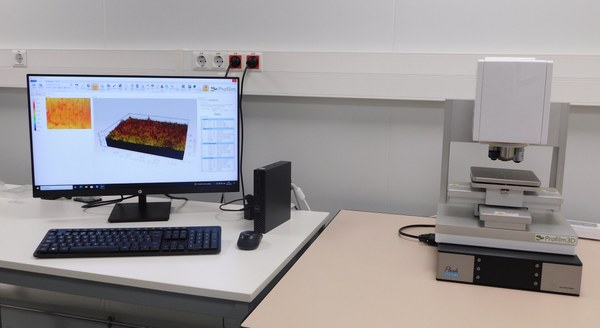Optical interferometry
Optical interferometry
Optical profilometry is a non-contact surface measurement technique based on the interference of light waves to obtain precise 3D topography maps. A light beam is split into two paths: one directed at a reference surface and the other one at the sample. When the reflected beams recombine, interference patterns form depending on the optical path difference. By analyzing these fringes, height variations on the sample surface can be measured with sub-nanometer vertical resolution.
The Profilm 3D equipment from KLA offers four interferometric measurement modes with different ranges and resolutions:
- Whit Light Interferometry (WLI): Uses a broadband low-coherence light, enabling absolute height measurements ideal for surfaces with steps or discontinuities.
- Green Light Interferometry (GLI): Employs monochromatic green light with a longer coherence length, allowing more measurement points on rough or complex surfaces but with slightly reduced vertical resolution.
- Phase Shift Interferometry (PSI): Captures multiple phase-shifted images under monochromatic light to achieve very high vertical resolution, though it requires stable environmental conditions.
- Composite WLI/PSI mode: Combines the advantages of both WLI and PSI, maintaining high resolution while extending the measurement range.
Key features
- Motorized Z-axis focus with a 100 mm travel range.
- 5 Mpixels camera.
- Motorized X-Y sample stage (100x100) mm enabling automated stitching measurements.
- Three magnification objectives available: 10x, 20x, and 50x.
- Integrated vibration-isolated table.
- Maximum Z-resolution of 50 nm (VSI mode) and under 1nm (PSI mode).

Contact
In order to book the equipment and for more information, please contact Judit Buxadera (tecnics.multiescala@upc.edu).
Share: